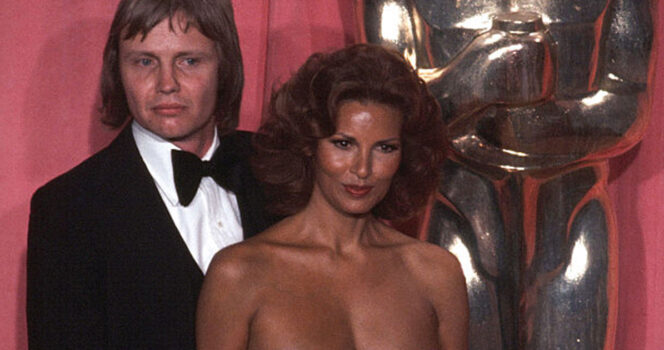Hollywood has always had its grand nights, but few remain as enduringly fascinating—or controversial—as the 47th Academy Awards, held in 1975. Nearly half a century later, that evening still sparks conversation, dissected for its glamour, its drama, and its lasting cultural resonance. Unlike today’s ceremonies, where speeches often come laden with political messaging, the 1975 Oscars struck a delicate balance between timeless Hollywood elegance and the turbulence of the era.
A Golden Age on Display
The Dolby Theatre didn’t exist yet, but the venue was just as grand: the Dorothy Chandler Pavilion in Los Angeles, gleaming under the glow of golden chandeliers. Stars in satin gowns and tuxedos paraded down the red carpet, their smiles flashing for photographers with blinding bulbs. Raquel Welch shimmered in a form-fitting gown that embodied 1970s boldness. Jon Voight, still establishing himself as one of Hollywood’s rising actors, cut a striking figure alongside her. Their photograph together, caught in a moment of intimacy and intrigue, would become one of the most iconic snapshots of the night.
In those days, the Oscars were less about social commentary and more about preserving an image of Hollywood as a palace of dreams. Yet beneath the surface, controversy stirred.
Dustin Hoffman’s Critique
Among the attendees, Dustin Hoffman, already an acclaimed star thanks to The Graduate and Midnight Cowboy, made headlines for his sharp criticism of the event itself. He openly questioned the pomp of the Oscars, calling into doubt the sincerity of its grandeur.
“Is this really about the art of film,” he asked reporters, “or is it about dressing up and clapping for ourselves?”
His words stung, echoing across news outlets in the following days. For some, Hoffman’s critique exposed what they had long suspected—that the Academy Awards were more spectacle than substance. For others, his candor seemed disrespectful, an unnecessary attack on a tradition many revered.
Sinatra’s Slip
If Hoffman’s comments fueled post-ceremony debates, Frank Sinatra added fire to the night itself. Invited to present, Sinatra carried himself with his usual swagger, a living legend in his own right. Yet, the evening did not go smoothly for him.
First, he stumbled over names on the teleprompter, leading to an awkward laugh from the crowd. Sinatra, always quick with wit, brushed it off, but the moment was replayed endlessly on television, a rare glimpse of imperfection from the otherwise untouchable crooner.
Then came something more serious: a comment against the Vietnam War. Though Sinatra was not known as a political firebrand, he chose that night to voice his disapproval of America’s continued involvement. The statement hung in the air, met with both applause and silence. For an audience deeply divided over the war, it was a bold choice—one that made the Oscars suddenly feel less like escapism and more like a mirror of the times.
The Image That Lasted
Amid the speeches and slips, one image endured: Jon Voight standing beside Raquel Welch, captured in a photograph that became emblematic of the evening. Welch, the epitome of Hollywood glamour, stood radiant, while Voight, younger and brooding, seemed to embody the new generation of stars rising within the industry.
The photograph has since been analyzed, reprinted, and endlessly discussed. Some saw it as a passing of the torch, a symbolic meeting of classic beauty and fresh talent. Others focused on the chemistry between the two, speculating endlessly about what the picture suggested. Whatever the interpretation, it became one of those rare cultural moments when a single image told a thousand stories.
A Night of Contradictions
What made the 1975 Oscars so memorable wasn’t just the list of winners or the gowns worn on the red carpet. It was the contradictions.
It was the tension between Hollywood’s desire to project glamour and the growing demand for authenticity. It was Hoffman’s biting critique against the backdrop of Welch’s dazzling poise. It was Sinatra’s anti-war comment clashing with the Academy’s desire to remain apolitical. It was the old Hollywood colliding with the new.
Films celebrated that evening, such as The Godfather Part II, reflected a darker, more complex era of filmmaking, one that mirrored the turbulence of society itself. The awards show became a stage not just for performances, but for the cultural shifts rippling through America in the mid-1970s.
Why It Still Resonates
Nearly fifty years later, the 1975 Academy Awards continue to spark debate for one reason: they captured Hollywood at a crossroads.
The night revealed the fragility of the façade—the way even a perfectly orchestrated ceremony could unravel with a few unscripted moments. Hoffman’s critique foreshadowed decades of questions about the relevance and authenticity of the Oscars. Sinatra’s slip highlighted how political tension could invade even the most glamorous of spaces. And that photograph of Voight and Welch remains proof that the Oscars are not just about trophies—they’re about images, icons, and moments that live on long after the lights dim.
In hindsight, the 47th Academy Awards were less about the films and more about the culture. They reflected an America struggling to balance optimism with disillusionment, entertainment with activism.
A Legacy of Glamour and Imperfection
Today, when people recall the 1975 Oscars, they often smile at the glamour, laugh at the mishaps, or debate the boldness of Sinatra’s words. But above all, they remember that night as uniquely human.
The Academy Awards have always aimed to be flawless. Yet in 1975, its flaws became its legacy. The imperfections, the drama, the cultural echoes—those are what made it unforgettable.
And so, nearly half a century later, the 1975 Oscars remain not just a ceremony but a story. A story of stars and scandals, of images and ideas, of Hollywood at its most dazzling and its most vulnerable.
